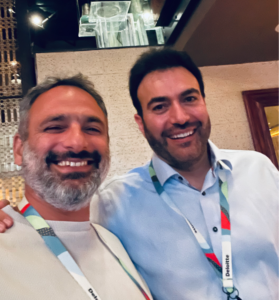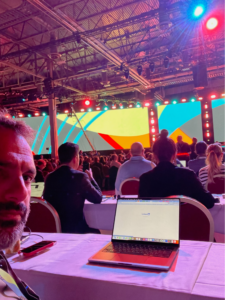Over the last year, I’ve been hearing the name “Oracle Cloud” a lot. And last week, I was invited to the Oracle CloudWorld annual event to learn more about this latecomer market player. As both an AWS user and blogger for the past 15 years, you can imagine the perceptions I came with to this traditional vendor conference.

In the cloud universe, the concept known as “data gravity” operates like a cosmic force of natur
e. Picture data as a celestial body with mass, like a planet. As this data planet grows, its gravitational pull strengthens, attracting applications and services like satellites, which orbit around it. Data has a “gravitational force,” much like planets exerting influence over their satellites.
In Oracle’s case, considering its enterprise market footprint—with some of the largest enterprises in the world running their massive
centralized data assets on Oracle’s technologies for years—this gravitational force is strong.
After spending three days at CloudWorld watching keynotes and engaging in discussions with high-level Oracle executives and its customers, I have to say, I was positively surprised; I came out with a totally different perception of the cloud hyperscaler than I had going in.
Veteran Enterprise-Grade Vendor
As I strolled through the conference halls, I couldn’t help but notice there wasn’t a single “geeky t-shirt” in sight. Everyone, and I mean everyone, was dressed in suits. I decided to forgo wearing my “Python is not a snake” t-shirt and opted for a more formal, buttoned-up look.

Over the years, Oracle has become a trusted partner of hundreds of thousands of enterprises worldwide, helping them meet their IT needs. This long-standing collaboration underscores Oracle’s unique position, with newer players like AWS having comparatively shorter histories in the enterprise IT landscape.
Oracle CEO Safra Catz presented a compelling case study of telecommunications giant TIM. Serving 62 million customers, TIM’s transformation journey involved migrating from traditional data centers to cloud-based infrastructure. Vacating their empty data centers and embracing Oracle cloud, despite its immaturities, was a real testament to the strong relationship between the two and to Oracle’s market sustainability.

Figure 1: Oracle CEO Safra Catz presenting at Oracle CloudWorld 2023
Despite being a latecomer to the IaaS market, Oracle seems to be slowly but surely building its position in the cloud market and is hoping to close their product and feature gaps with AWS and Azure soon.
Oracle Cloud Gen 2
In his keynote, Oracle Founder Larry Ellison—who by the way, creates all of his presentations himself—shared the story of how their first attempt to build their cloud (Oracle Cloud Gen 1) had failed miserably, not recognizing that AWS wasn’t just another colocation or website hosting platform but a serious contender in the world of enterprise IT.
Ellison is certainly not one to mince words. And if you haven’t heard him speak before, I highly recommend checking out this past video on the world of cloud.
“It’s this nonsense. What are you talking about? It’s not water vapor! All it is is a computer attached to a network.” —Oracle Founder Larry Ellison, 2009 interview
This interview only shows how Oracle (and other vendors such as HP) were so locked into their traditional perceptions. In the past, I’ve said HP would break apart; and it did. Oracle won’t.
I had the opportunity to discuss Oracle Cloud Gen 2 with Eran Feigenbaum, SVP and Oracle Israel country leader. He recounted how Oracle had proactively established a cloud startup team in Seattle:
“We strategically acquired top cloud talent from leading competitors. Over the past few years, we’ve diligently invested in constructing our cloud Infrastructure (IaaS) offerings from the ground up.”
In 2018, almost a decade after the Ellison interview, Oracle introduced Cloud Gen 2, which took a different approach to architecture: Customer code, data, and resources run on bare-metal machines, while the Oracle cloud management layer runs on separate hardware.
Oracle has formed strategic partnerships to enhance its cloud offerings, including an alliance with Nvidia to bring high-performance GPU capabilities to Oracle Cloud by leveraging Nvidia H100 GPUs. This combined with applying remote data memory access (RDMA) to clustering have given Oracle a competitive edge when it comes to running AI operations, including model training. According to Ellison, applications running on Oracle Cloud can achieve speeds up to twice as fast at half the cost.

Figure 2: Ofir Nachmani, IOD CEO and Eran Feigenbaum, Oracle SVP and Israel Country Leader (Source:IOD)

Figure 3: Oracle Founder Larry Ellison presenting the key features of Oracle Gen2 Cloud at Oracle CloudWorld 2023 (Source: IOD)
In a cosmos where cloud costs can quickly skyrocket, Oracle could present a more affordable and manageable cloud option, particularly for heavy workloads. This cost comparison of AI infrastructure in the cloud (primarily focusing on Oracle Cloud Infrastructure (OCI) shows it can be a cost-effective choice for specific intensive ML workloads, offering an average of 35% lower costs compared to other cloud providers like AWS. Another key feature is that OCI charges the same for services regardless of region, including government regions, which certainly simplifies cost management for their users. And I would imagine it simplifies management for Oracle as well.
Addressing the Gaps in Oracle’s Partner Network
No company operates in a vacuum; it must build and nurture its ecosystem to offer clients a comprehensive solution created by both its core capabilities and those of its partners. As I’ve stressed in multiple blog posts over the years, in the cloud world, collaboration is essential. It must be a strategic priority in any provider’s go-to-market strategy. This should include elements like a marketplace of independent solution vendors (ISVs) and managed service providers (MSPs) with automated processes for client onboarding, resource reselling, and solution integration.
Along these lines, in his keynote, Ellison introduced Oracle’s commitment to an open world of cloud to support connected multicloud environments. All Oracle clouds provide the same services while varying in size, allowing for full automation, enhanced security, and reliability as well as deployment of these “clouds” (Since these seem to have small footprints, we should avoid calling them “regions.”).
In addition to Oracle’s expansive cloud footprint, with 64 “clouds” globally, he emphasized the importance of collaboration, citing a meeting with Microsoft’s Satya Nadella to establish Oracle clouds within Azure data centers. Azure will be providing comprehensive support for various Oracle database services, encompassing Oracle Exadata Database services and Autonomous Database services.

While Oracle maintains a strong network of strategic partners, as noted, when it comes to its ecosystem of midsize companies to startups, the partners exhibition floor was very weak.
According to an Oracle executive I spoke with, the company has been promoting a “Partners First” approach. To this end, Oracle introduced Oracle Alloy, which enables partners to become cloud providers. In addition, Oracle has been leveraging joint marketing efforts, co-funded campaigns, and client referral programs with its partners.
Still, you can’t ignore the number of apps in OCI’s marketplace lagging significantly behind those of these Magic Quadrant leaders. Since the early days of AWS, its ecosystem has been a major enabler, accelerating customer adoption by closing gaps with partner solutions (e.g., support of different databases, monitoring tools, and cloud security platforms).
On the MSP ecosystem front, OCI also faces challenges, with an underdeveloped ecosystem and a lack of full commitment from infrastructure MSPs and global systems integrators. From my discussions with Oracle executives, they recognize this weakness, but commented that 70% of all implementations are handled by their third-party partners while working toward their goal of 90%.
Oracle G2M: Enterprise-First
In an interesting discussion with Oracle VP Products and Strategy Leo Leung, I raised the point about Oracle’s lack of a bottom-up, dev-related go-to market. Leung’s response was simply that Oracle’s main focus has been on top-down, targeting high-level decision-makers.
It made perfect sense to me, and I agreed with the approach. This ensures alignment with the goals and vision of enterprise leadership, really differentiating Oracle from competitors like AWS and Google. And considering that some say Google cloud has no real strategic go-to-market agenda, we might assume that Oracle, with its enterprise-first approach, will soon find itself third after Microsoft.
Nonetheless, Oracle has faced a mixed reputation in the tech industry, with some citing concerns about its historically aggressive licensing practices and the perception of being less user-friendly than other, more modern IT cloud providers. These factors have led to challenges in customer adoption, making many enterprises reluctant to move to OCI, and even opting to leave their long-running Oracle workloads on other clouds. In addition, it seems like OCI’s sales efforts and partner network are ill-suited for non-Oracle workloads, mid-market, and SMBs, thereby limiting its adoption in these segments.
Final Notes
Following on my previous point, though a long-term and risky investment for Oracle, over the next few years, the cloud hyperscaler will have to align its strategy with AWS and Azure, adopting a bottom-up approach to target the developer community in addition to its successful top-down go-to-market agenda. It may well be that its partnership with Azure plants the seed for this. It won’t be easy for Oracle, as it hasn’t been for other traditional IT vendors, but I hope they’ll pursue the same path as Microsoft has over the past few years.
In my many years covering the cloud industry, I’ve witnessed the rapid evolution of the enterprise IT landscape and especially the public cloud. And despite entering the cloud arena later than some, Oracle is actively charting its course to establish itself as a major leader in the cloud domain. And I believe it has already ensured its relevance in the decades to come.
In the end, the Oracle CloudWorld event surprised me. While I had expected it might just be another cloud washing event, my impression in the end was that of a truly committed vendor with a clear and proven go-to market, perfect leadership alignment, and a strong customer-centric approach. Oracle has great potential to join the landlords of cloud and to play a major role in the enterprise cloud market.

